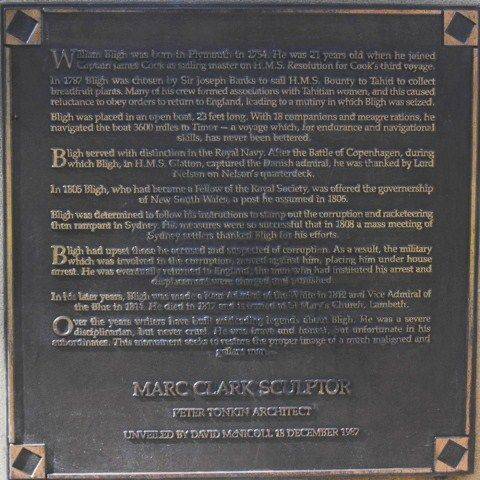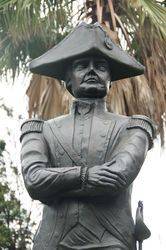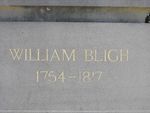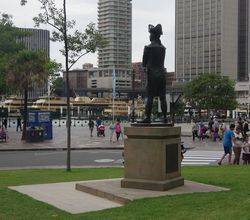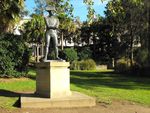
William BlighPrint Page 
The statue of Captain William Bligh was erected in 1987 to ' restore the proper image of a much maligned and gallant man.' Bligh was Governor of New South Wales from 1806 to 1809.
Vice Admiral William Bligh (9 September 1754 – 7 December 1817) was an officer of the British Royal Navy and a colonial administrator. A notorious mutiny occurred during his command of HMS Bounty in 1789; Bligh and his loyal men made a remarkable voyage to Timor, after being set adrift in the Bounty's launch by the mutineers. Fifteen years after the Bounty mutiny, he was appointed Governor of New South Wales in Australia, with orders to clean up the corrupt rum trade of the New South Wales Corps, resulting in the so-called Rum Rebellion.
On 26 January 1808, the New South Wales Corps under Major George Johnston marched on Government House in Sydney and arrested him. A rebel government was subsequently installed and Bligh, now deposed, made for Hobart in Tasmania aboard HMS Porpoise. Bligh failed to gain support from the authorities in Hobart to retake control of New South Wales, and remained effectively imprisoned on the Porpoise from 1808 until January 1810. Thus isolated, Bligh stayed until Governor Lachlan Macquarie arrived in Sydney. He returned to Port Jackson on 17 January 1810, but did not finally sail for England until 12 May. After Johnston's trial, Bligh received his routine promotion, first to rear admiral of the Blue, which was backdated to July 1810 when it had become due, and then to vice-admiral in June 1814.
Location
| Address: | 112 George Street, Bligh & Barney Reserve, The Rocks, 2000 |
|---|---|
| State: | NSW |
| Area: | AUS |
| GPS Coordinates: | Lat: -33.859108 Long: 151.209271 Note: GPS Coordinates are approximate. |
Details
| Monument Type: | Statue |
|---|---|
| Monument Theme: | People |
| Sub-Theme: | Government - Colonial |
| Approx. Event Start Date: | 1806 |
| Approx. Event End Date: | 1809 |
| Designer: | Peter Tonkin |
| Artist: | Marc Clark |
| Link: | http://adbonline.anu.edu.au/adbonli… |
Dedication
| Actual Monument Dedication Date: | Friday 18th December, 1987 |
|---|
William Bligh
1754 - 1817
William Bligh was born in Plymouth in 1754. He was 21 years old when he joined Captain James Cook as sailing master on H.M.S. Resolution for Cook's third voyage.
In 1787 Bligh was chosen by Sir Joseph Banks to sail H.M.S. Bounty to Tahiti to collect breadfruit plants. Many of his crew formed associations with Tahitian women, and this caused reluctance to obey orders to return to England, leading to a mutiny in which Bligh was seized.
Bligh was placed in an open boat, 23 feet long. With 18 companions and meagre rations, he navigated the boat 3600 miles to Timor - a voyage which, for endurance and navigational skills, has never been bettered.
Bligh served with distinction in the Royal Navy. After the Battle of Copenhagen, during which Bligh, in H.M.S. Glatton, captured the Danish admiral, he was thanked by Lord Nelson on Lord Nelson's quarterdeck.
In 1805 Bligh, who had become a Fellow of the Royal Society, was offered the governorship of New South Wales, a post he assumed in 1806.
Bligh was determined to follow his instructions to stamp out the corruption and racketeering then rampant in Sydney. His measures were so successful that in 1808 a mass meeting of Sydney settlers thanked Bligh for his efforts.
Bligh had upset those he accused and suspected of corruption. As a result, the military which was involved in the corruption, moved against him, placing him under house arrest. He was eventually returned to England ; the men who had instituted his arrest and displacement were charged and punished.
In his later years, Bligh was made a Rear Admiral of the White in 1812 and Vice Admiral of the Blue in 1814. He died in 1817 and is buried at St Mary's Church, Lambeth.
Over the years writers have built misleading legends about Bligh. He was a severe disciplinarian, but never cruel. He was brave and honest, but unfortunate in his subordinates. This monument seeks to restore the proper image of a much maligned and gallant man.
Mark Clark Sculptor
Peter Tonkin Architect
Unveiled by David McNicoll
18 December 1987



